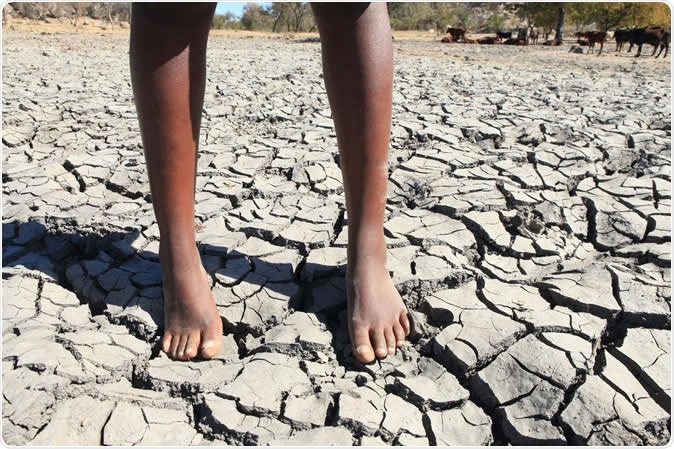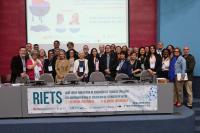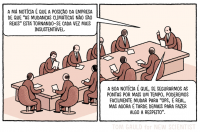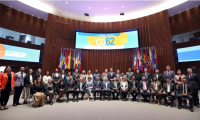WHO releases urgent health challenges for the next decade
 The World Health Organization (WHO) spells out last January 13th what we need to realize for health, that is an investment in the future. According to WHO, 'countries invest heavily in protecting their people from terrorist attacks, but not against the attack of a virus, which could be far more deadly, and far more damaging economically and socially'. "A pandemic could bring economies and nations to their knees. Which is why health security cannot be a matter for ministries of health alone", the Organization said.
The World Health Organization (WHO) spells out last January 13th what we need to realize for health, that is an investment in the future. According to WHO, 'countries invest heavily in protecting their people from terrorist attacks, but not against the attack of a virus, which could be far more deadly, and far more damaging economically and socially'. "A pandemic could bring economies and nations to their knees. Which is why health security cannot be a matter for ministries of health alone", the Organization said.
All the challenges in this list demand a response from more than just the health sector. We face shared threats and we have a shared responsibility to act. With the deadline for the 2030 Sustainable Development Goals quickly approaching, the United Nations General Assembly has underscored that the next 10 years must be the "decade of action". This means advocating for national funding to address gaps in health systems and health infrastructure, as well as providing support to the most vulnerable countries. Investing now will save lives – and money – later. The cost of doing nothing is one we cannot afford. Governments, communities, and international agencies must work together to achieve these critical goals. There are no shortcuts to a healthier world. 2030 is fast approaching, and we must hold our leaders accountable for their commitments, as stated by Dr Tedros Adhanom Ghebreyesus, WHO Director-General.
-
Keeping health care clean
What’s the challenge?
The climate crisis is a health crisis. Air pollution kills an estimated 7 million people every year, while climate change causes more extreme weather events, exacerbates malnutrition and fuels the spread of infectious diseases such as malaria. The same emissions that cause global warming are responsible for more than one-quarter of deaths from heart attack, stroke, lung cancer and chronic respiratory disease. Leaders in both the public and private sectors must work together to clean up our air and mitigate the health impacts of climate change.
What is WHO doing?
In 2019, over 80 cities in more than 50 countries committed to WHO’s air quality guidelines, agreeing to align their air pollution and climate policies. This year, WHO will work towards developing a set of policy options for governments to prevent or reduce the health risks of air pollution.
-
Delivering health in conflict and crisis
What’s the challenge?
In 2019, most disease outbreaks requiring the highest level of WHO response occurred in countries with protracted conflict. We also saw the continuation of a disturbing trend in which health workers and facilities are targeted. WHO recorded 978 attacks on health care in 11 countries last year, with 193 deaths. At the same time, conflict is forcing record numbers of people out of their own homes, leaving tens of millions of people with little access to health care, sometimes for years.
What is WHO doing?
Last year WHO responded to 58 emergencies in 50 countries. We deploy mobile medical teams, improve disease detection and warning systems, conduct vaccination campaigns, distribute medicines and train health workers. WHO is working to save lives and prevent suffering by working with countries and partners to strengthen health systems, improve preparedness and expand the availability of long-term contingency financing for complex health emergencies.
But health is only part of the equation. Ultimately, we need political solutions to resolve protracted conflicts, stop neglecting the weakest health systems, and protect health care workers and facilities from attacks.
-
Making health care fairer
What’s the challenge?
Persistent and growing socio-economic gaps result in major discrepancies in the quality of people’s health. There’s not only an 18-year difference in life expectancy between rich and poor countries, but also a marked gap within countries and even within cities. Meanwhile, the global rise in noncommunicable diseases, such as cancer, chronic respiratory disease and diabetes, has a disproportionately large burden in low and middle-income countries and can quickly drain the resources of poorer households.
What is WHO doing?
WHO is working with its partners to improve child and maternal care, nutrition, gender equality, mental health, and access to adequate water and sanitation. WHO will also provide guidance on how countries can better reduce inequality in health care, such as by improving the governance and management of public and private health services.
One of the best ways to reduce inequalities is through primary health care, which addresses the majority of a person’s health needs. WHO is calling for all countries to allocate 1% more of their gross domestic product to primary health care, to give more people access to the quality essential services they need, close to home.
-
Expanding access to medicines
What’s the challenge?
About one-third of the world’s people lack access to medicines, vaccines, diagnostic tools and other essential health products. Low access to quality health products threatens health and lives, which can both endanger patients and fuel drug resistance. Medicines and other health products are the second-largest expenditure for most health systems (after health workers) and the largest component of private health expenditure in low- and middle-income countries.
What’s WHO doing?
This year, WHO will sharpen its focus on priority areas for global access. These include fighting substandard and falsified medical products; enhancing the capacity of low-income countries to assure the quality of medical products throughout the supply chain; and improving access to diagnosis and treatment for noncommunicable diseases, including diabetes.
-
Stopping infectious diseases
What’s the challenge?
Infectious diseases like HIV, tuberculosis, viral hepatitis, malaria, neglected tropical diseases and sexually-transmitted infections will kill an estimated 4 million people in 2020, most of them poor. Meanwhile, vaccine-preventable diseases continue to kill, such as measles, which took 140,000 lives in 2019, many of them children. Although polio has been driven to the brink of eradication, there were 156 cases of wild poliovirus last year, the most since 2014.
The root causes are insufficient levels of financing and the weakness of health systems in endemic countries, coupled with a lack of commitment from wealthy countries.
What’s WHO doing?
There’s an urgent need for greater political will and increased funding for essential health services; strengthening routine immunization; improving the quality and availability of data to inform planning, and more efforts to mitigate the effects of drug resistance. There’s also a need to invest in research and development of new diagnostics, medicines and vaccines. Together with partners, WHO is working to end polio as soon as possible.
-
Preparing for epidemics
What’s the challenge?
Every year, the world spends far more responding to disease outbreaks, natural disasters and other health emergencies than it does preparing for and preventing them. A pandemic of a new, highly infectious, airborne virus - most likely a strain of influenza - to which most people lack immunity is inevitable. It is not a matter of if another pandemic will strike, but when, and when it strikes it will spread fast, potentially threatening millions of lives. Meanwhile, vector-borne diseases like dengue, malaria, Zika, chikungunya, and yellow fever are spreading as mosquito populations move into new areas, fanned by climate change.
What is WHO doing?
WHO is advising countries on evidence-based investments to strengthen health systems and infrastructure to keep populations safe when health emergencies strike. The 2019 Global Preparedness Monitoring Board report identified seven concrete steps that countries and multilateral institutions should adopt, including more international cooperation, greater domestic focus on preparedness and increased funding.
-
Protecting people from dangerous products
What’s the challenge?
Lack of food, unsafe food and unhealthy diets are responsible for almost one-third of today’s global disease burden. Hunger and food insecurity continue to plague millions, with food shortages being perniciously exploited as weapons of war. At the same time, as people consume foods and drinks high in sugar, saturated fat, trans fat and salt, overweight, obesity and diet-related diseases are on the rise globally. Meanwhile, tobacco use is declining in a few but rising in most countries, and evidence is building about the health risks of e-cigarettes.
What is WHO doing?
WHO is working with countries to develop evidence-based public policies, investments and private sector reforms to reshape food systems, and provide healthy and sustainable diets. In 2019 the food industry committed to eliminating trans fat by 2023, but more is needed. WHO is working with countries to build political commitment and capacity to strengthen implementation of evidence-based tobacco control policies.
-
Investing in the people who defend our health
What’s the challenge?
Chronic under-investment in the education and employment of health workers, coupled with a failure to ensure decent pay, has led to health worker shortages all over the world. This jeopardizes health and social care services and sustainable health systems. The world will need 18 million additional health workers by 2030, primarily in low- and middle-income countries, including 9 million nurses and midwives.
What is WHO doing?
To trigger action and encourage investment in education, skills and jobs, the World Health Assembly has designated 2020 the Year of the Nurse and the Midwife. WHO, with partners, will issue a comprehensive State of the World’s Nursing report on World Health Day in April. We’re working with countries to stimulate new investment to train health workers and pay them decent salaries
-
Keeping adolescents safe
What’s the challenge?
More than 1 million adolescents aged 10-19 years die every year. The leading causes of death in this age group are road injury, HIV, suicide, lower respiratory infections, and interpersonal violence. Harmful use of alcohol, tobacco and drug use, lack of physical activity, unprotected sex, and previous exposure to child maltreatment all increase the risks for these causes of death.
What is WHO doing?
In 2020, WHO will issue new guidance for policymakers, health practitioners and educators, called Helping Adolescents Thrive. The aim is to promote adolescents’ mental health and prevent the use of drugs, alcohol, self-harm and interpersonal violence, as well as provide young people with information on preventing HIV and other sexually transmitted infections, contraception, and care during pregnancy and childbirth. WHO will continue to work with governments on improving emergency trauma care following severe injuries (e.g. due to gunshots and road traffic crashes).
-
Earning public trust
What’s the challenge?
Trust helps to shape whether patients are likely to rely on health services and follow a health worker’s advice - around vaccinations, taking medicines, or using condoms. Public health is compromised by the uncontrolled dissemination of misinformation in social media, as well as through an erosion of trust in public institutions. The anti-vaccination movement has been a significant factor in the rise of deaths in preventable diseases.
What is WHO doing?
WHO is working with countries to strengthen primary health care, so people can access effective and affordable services easily, from people they know and trust, in their own communities. We're working with Facebook, Pinterest and other social media platforms to ensure their users receive reliable information about vaccines and other health issues.
Building scientific literacy and health education is vital. There’s a need, too, for self-reflection: scientists and the public health community need to do a better job of listening to the communities they serve. Finally, we must invest in better public health data information systems.
-
Harnessing new technologies
What’s the challenge?
New technologies are revolutionizing our ability to prevent, diagnose and treat many diseases. Genome editing, synthetic biology, and digital health technologies such as artificial intelligence can solve many problems, but also raise new questions and challenges for monitoring and regulation. Without a deeper understanding of their ethical and social implications, these new technologies, which include the capacity to create new organisms, could harm the people they are intended to help.
What is WHO doing?
In 2019 WHO set up new advisory committees for human genome editing and digital health, bringing together the world’s leading experts to review evidence and provide guidance. WHO is also working with countries to enable them to plan, adopt, and benefit from new tools that provide clinical and public health solutions, while supporting better regulation of their development and use.
-
Protecting the medicines that protect us
What’s the challenge?
Anti-microbial resistance (AMR) threatens to send modern medicine back decades to the pre-antibiotic era, when even routine surgeries were hazardous. The rise of AMR stems from myriad factors that have come together to create a terrifying brew, including unregulated prescription and use of antibiotics, lack of access to quality and affordable medicines, and lack of clean water, sanitation, hygiene and infection prevention and control.
What is WHO doing?
WHO is working with national and international authorities in the environment, agriculture and animal sectors to reduce the threat of AMR by addressing its root causes, while advocating for research and development into new antibiotics.
-
Keeping health care clean
What’s the challenge?
Roughly one in four health facilities globally lack basic water services. Water, sanitation and hygiene (WASH) services are critical to a functioning health system. The lack of these basics in health facilities leads to poor-quality care and an increased chance of infection for patients and health workers. All of this is happening against a backdrop of billions of people around the world living in communities without safe water to drink or adequate sanitation services – both of which are major drivers of disease.
What is WHO doing?
WHO and its partners are currently working with 35 low and middle-income countries to improve the water, sanitation and hygiene conditions in their health facilities. The global goal is for all countries to have included WASH services in plans, budgets and implementation efforts by 2023, and by 2030 all health care facilities globally should have basic WASH services.



